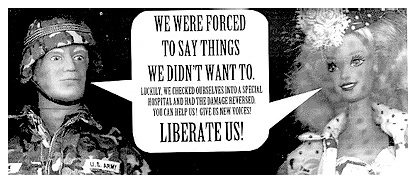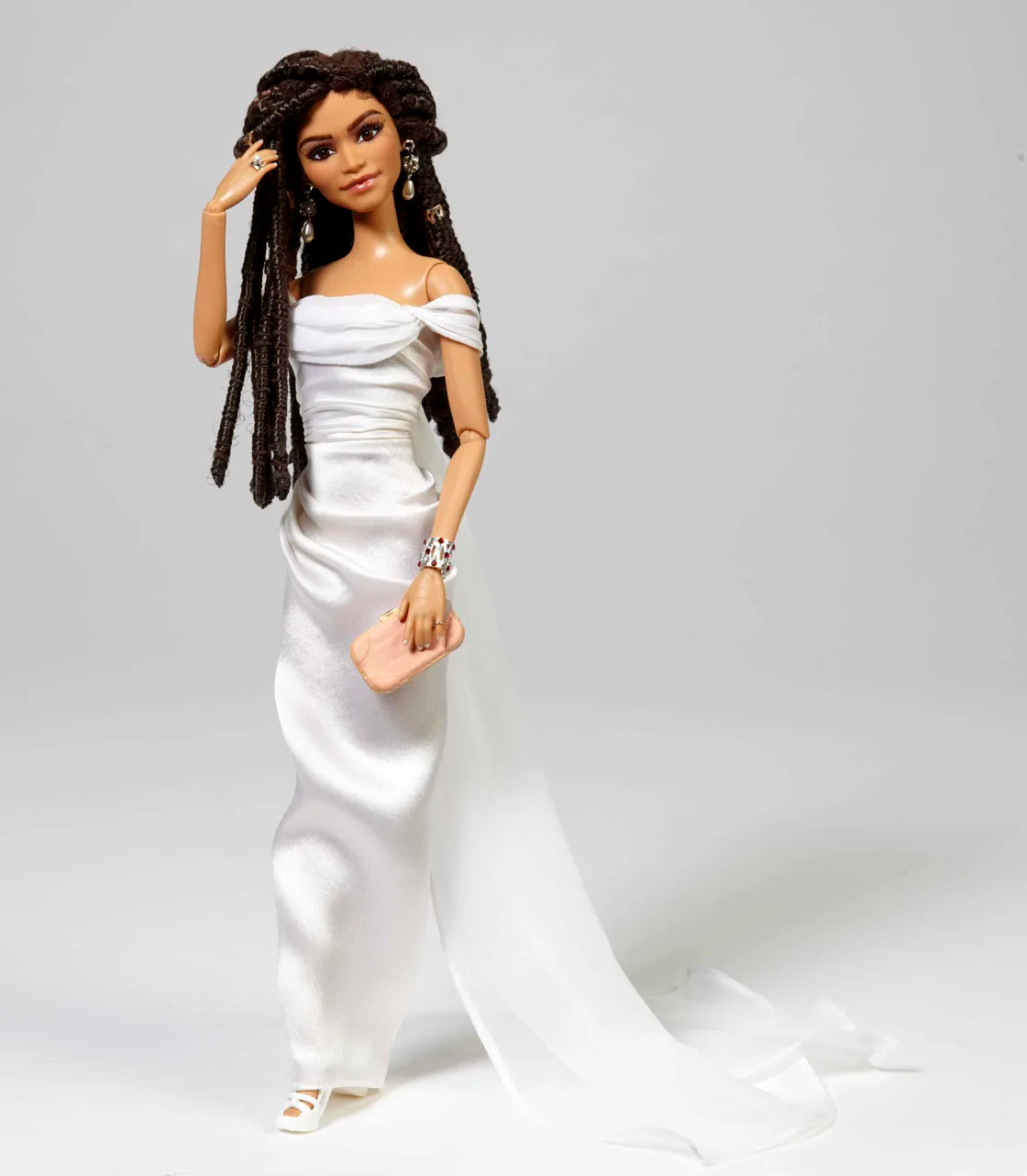Protest Barbie
The Barbie Liberation Organization, activist Ken dolls storming the Mattel building, and more.
Barbie. Maybe you’ve heard of her? She used to be a symbol of women’s oppression, then they made her more diverse and gave her a job in STEM and she became a feminist icon. Currently she’s starring in a bazillion-dollar movie that seems to be giving Ryan Gosling’s career more of a boost than Margot Robbie’s. Whoops!
Big-budget Barbie’s life path is similar to the doll’s. She starts out happy in her pretty pink life, grows dissatisfied with its limitations, changes her wardrobe, and explores other careers, complete with the ultimate feminist accessory—a hot, supportive partner. It’s a narrative that will resonate with white feminists my age, who almost all have a personal story about their ambivalent relationship to pink, compulsory heterosexuality, prettiness, dolls, diet culture, fashion, or some combination thereof. Kudos to Gerwig for knowing her audience, but honestly, I left the theater feeling the same way about the movie as I did about Hillary Clinton’s presidential campaign, which is to say: “Is this the best we can do?”
I decided to cheer myself up by looking back at all the times people used Barbie to fuck shit up. Read on!
Superstar
In 1987 Todd Haynes released Superstar: The Karen Carpenter Story, a 45-minute biopic about the final years of musician Karen Carpenter, who died from anorexia-related health complications in 1983. The movie has a lot of myth and mystery around it, mostly because for years no one could see it—Carpenter’s brother Richard sued Haynes and even now it’s only available as a bootleg.
The controversy overshadowed what a fucking great movie this is, especially in its representation of how families conspire to ignore self-destruction and suicidal self-abuse by filling the air with mundane conversations. By the end of Superstar, Carpenter’s death makes perfect sense. She had no other way to be herself.
The Barbie Liberation Organization
When Mattel dropped a Barbie who thought math was hard in 1992, a group of artists decided to hack her voice box and give her something else to say. They swapped her voice box with GI Joe’s and released the dolls back into the wild, allowing consumers to experience Barbie saying things like “Vengeance is mine,” and “Dead men tell no tales,” while Joe became the one who struggled with math.
There was a lot of doll hacking going on in the 90s—the Cacophony society made a bunch of dioramas about war atrocities and infiltrated a GI Joe convention, and the Barbie Disinformation Organization went into toy stores to put their own labels on Barbie products, turning “Barbie’s Styling Salon” into “Barbie’s Lesbian Barbershop.”
One of the artists involved with the BLO went on to found The Yes Men and made a documentary about the project. I love it. Why don’t we do stuff like this anymore?
Pink Anger Barbie
When Mattel reissued Poodle Parade Barbie (seriously) in 1996, there was a noticeable decline in quality from the original 1965 edition. Collectors were not enthused when they removed her scarf to discover that underneath it Barbie looked more like Moe from the Three Stooges than a young lady out parading her poodle.
The collectors complained, conducted a “Pink Tidal Wave” letter campaign, and organized a boycott. Initially Mattel fought back by suing some zines that had written negatively about Barbie, and even threatened their internet providers, but that only resulted in a full-fledged Pink Anger movement. Mattel ended up backing down and offering to send a retooled new Poodle Parade Barbie head with a better haircut to anyone who sent in their old one. Consumer victory!
Climate Death Barbie
This is…incredible? In 2011 Greenpeace activists dressed as Ken dolls rappelled down Mattel headquarters in Los Angeles to unfurl a banner accusing Barbie and her manufacturer of contributing to the destruction of the rainforest. A supreme event!!!
Crazily enough, it worked, and Mattel released new sustainable sourcing principles that addressed Greenpeace’s concerns. I purposefully did not investigate this claim because I want us all to have a good weekend and if I have to get into greenwashing after purposefully not discussing pinkwashing, that is not likely to happen.
Greenpeace went hard, though. They also had a Barbie bulldozer, but she was detained by police before arriving. And a woke pre-Gosling Ken starred in a video series where he learned about Barbie’s packing practices and made a “desperate” phone call to beg Mattel to change its ways. Soft masc can still be strong.
Occupy Barbie Dreamhouse
In 2013, when Mattel built a 26,900 square foot Barbie Dreamhouse in Berlin, protestors from Femen crucified Barbie and then set fire to the crucifix to make sure everyone got the message. Then they slightly undercut their statement by touring the show and telling a reporter that they enjoyed it.
Art Activist Barbie
Art historian Sarah Williamson created the twitter account Barbie Reports in 2018 to playfully point out patriarchal messages in painting, sculpture, and the art world at large. Impeccably dressed Barbies holding protest signs have since appeared in the Uffizi, the National Gallery, the Musee D’Orsay, and St. Peter’s Basilica. Art Activist Barbie’s rhetoric is strongly second wave—you won’t find her talking about labor, colonialism, or class issues—but she’s so damn perky you kind of end up rooting for her, like Reese Witherspoon in Election.
Zendaya’s Locs Barbie
Only Zendaya claps back with a custom one-of-a-kind Barbie wearing Vivienne Westwood. Mattel created the doll, an exact replica of Zendaya’s 2015 Oscar look, as a response to Giuliana Rancic’s racist remark that the actress looked like she smelled “of patchouli and weed.”
They also created the doll as part of the marketing around the Barbie Rock ‘N Royals Concert Experience, hosted by Zendaya, which is where she made her debut. It kind of makes me wonder if she was really necessary, especially when Zendaya herself spoke eloquently about locs and “ignorant people who judge others by the curl of their hair” in the immediate aftermath of Rancic’s comment.
Is it even possible to get outside Barbie enough to use her to tell a non-Barbie story? Her cultural weight seems to drag down any narrative where she is not triumphant, not least because of Mattel’s ability to absorb protest, turn it into a Barbie, and sell it right back to the public. Maybe that’s why the Barbie movie depressed me so much. I wanted it to be real.
Deeper Links
What does Barbie have to do with “a raunchy sex comedy with breakdancing scenes?” Only the inimitable Jacqui Shine could explain in her piece on Ken Handler, the inspiration for Ken, and his movie-making career.
Just when I was tired of feminists writing about Barbie (ok, that happened decades ago), that damn Andi Zeisler went and said smart things in the NYT.
The Times wouldn’t let me do a gift link for this one, but in 1994 Anna Quindlen wrote a remarkable piece blaming Barbie for eating disorders, breast implants, and bizarrely, if unintentionally, implying that Black women were lucky to not have representation in Barbie world because otherwise they’d also be suffering.
I have to include photographer Beth Garrabarant’s incredible Barbie funeral photo essay from Damn Joan, although I think I brought it down a bit with my clunky copy. Sorry, Beth.










If you're in NYC, cinemovil is showing Superstar, the Todd Haynes Barbie/Karen Carpenter movie tonight! Along with some short films including The Brand That Feeds You.
https://twitter.com/cinemovilnyc/status/1682426120187027459